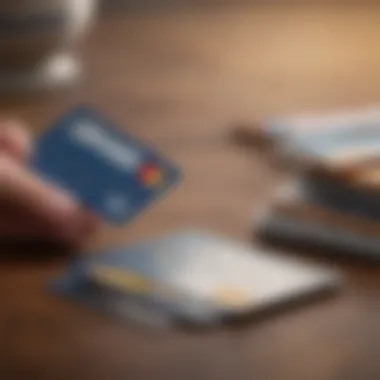Top Strategies for Managing Credit Card Debt


Intro
As personal finance becomes a focal point for many, particularly with the rise in living costs, there is a demand for solutions that simplify debt management. Whether you're struggling with multiple credit cards accumulating high-interest rates or just seeking ways to enhance your overall financial health, consolidating these debts can create a clearer path forward.
By examining various strategies—like balance transfers, debt consolidation loans, and counseling services—this article aims to empower readers. The greater objective is not just to inform but to equip you with the tools needed to navigate your financial landscape more effectively. Let's set the stage for what lies ahead by breaking down some key terms and concepts crucial to this process.
Key Terms Explained
Understanding the terminology is crucial for successfully navigating the world of debt consolidation. Below, we delineate some fundamental concepts that can illuminate the options available.
Fundamental Concepts
- Debt Consolidation: This process involves combining several debts into a single loan, which typically comes with a lower interest rate. It can simplify payments and help one manage owed amounts more effectively.
- Balance Transfer: This is when you move the balance of one credit card to another, often to take advantage of a lower interest rate during a promotional period. This can be a beneficial strategy if you pay off the transferred balance before the promotional rate expires.
- Credit Counseling: This service provides individuals with advice on managing debts, budgeting, and understanding credit scores. Counselors can also negotiate with creditors on your behalf, aiming to reduce monthly payments.
- Credit Score: An essential figure that lenders use to evaluate the risk of lending to an individual. High credit scores can lead to better interest rates and loan terms.
Understanding Credit Card Debt
Understanding credit card debt is crucial in the broader conversation about financial health. People often find themselves in a cycle of borrowing without fully comprehending the implications of their choices. Grasping what credit card debt entails opens the door to more informed decisions and effective strategies for managing or even eliminating it. Without this foundational knowledge, individuals may end up making decisions that compound their troubles rather than alleviate them.
Defining Credit Card Debt
Credit card debt is essentially the amount of money a consumer owes to their credit card issuer. This debt accumulates when purchases are made using a credit card without full repayment by the due date. The beauty—or perhaps the beast—of credit is that it allows for immediate gratification, but the price tag becomes evident when interest rates kick in. Each unpaid balance transforms into a financial burden that can spiral out of control. Simply put, if you spend more than you can afford and fail to pay it back in time, credit card debt grows like a weed in a garden.
Causes of Accumulating Credit Card Debt
There are various reasons people find themselves swimming in credit card debt.
- Impulse Spending: The ease of swiping a card can lead to unplanned purchases that, if not controlled, add up quickly.
- Unexpected Expenses: Life can throw curveballs—medical emergencies, car repairs, or sudden job loss can put a strain on finances, leading to reliance on credit.
- Lack of Budgeting: Not having a clear budget may mean overspending without realizing it, allowing debt to quietly pile up.
- Reliance on Minimum Payments: Paying only the minimum due often feels manageable at the time but can result in long-term financial strain, as most of the payment goes toward interest.
Each of these factors contributes to the ever-growing issue of credit card debt, creating a cascading effect on financial well-being.
The Impact of High-Interest Rates
One of the most insidious aspects of credit card debt is the high-interest rates that most cards come with. The average interest rate on credit cards can range from 15% to 25%, and in some extreme cases, even higher. This means that each month, the longer you carry a balance, the more you end up owing. Consider this: if you have a balance of $1,000 with a 20% interest rate, you could find yourself paying about $200 in interest within a year—money that could have gone toward actual loans or savings.
"Keeping your head above water is difficult when the tide of high-interest debt pulls you under."
In summary, higher interest rates not only make it tougher to pay off the principle but can also frustrate effective financial planning. Understanding the nuances of credit card debt helps individuals recognize their vulnerabilities and take proactive steps to overcome challenges in managing their finances.
Evaluating Personal Financial Situations
Before diving headfirst into credit card debt consolidation, it’s crucial to take a good look at one’s financial situation. This evaluation acts as the cornerstone for selecting the right method to tackle debt. By understanding where you stand financially, not only do you establish a clearer picture of your obligations, but you also highlight areas that might need adjusting. Looking at personal finances is like inspecting the undercarriage of a car before taking it on a road trip. You may uncover issues that, if left unattended, could lead to serious problems down the line.
Assessing Current Debt Levels
The first place to start is by assessing your current debt levels. It’s vital to gather all necessary data regarding your credit card debts. This includes the amount owed on each card, the associated interest rates, and minimum monthly payments. Having this information laid out clearly enables you to spot trends. Are you consistently hovering at your credit limits? Are payments primarily going towards interest rather than the principal?
This assessment is not just about numbers; it’s also an emotional exercise. Knowing the exact amount of what is owed can be daunting, but it’s a necessary step toward regaining control. Many individuals find that confronting their debt head-on provides a sense of empowerment.
To aid in this assessment, consider:
- Total amount owed: List each credit card debt.
- Interest rates: Note the rates, which will help in choosing a consolidation strategy later.
- Minimum payments: This will reveal how much you’re really paying versus how much you owe.
Examining Monthly Income and Expenses
After clarifying your debt situation, the next logical step is examining your monthly income and expenses. The balance between these is what fuels your financial engine. Understandly, it’s not just about bringing money in, but also how much is going out. Some folks in this situation might feel like they’re stuck in a financial hamster wheel, making ends meet without progress.
Start by documenting all sources of monthly income. Don’t just rely on your paycheck; think broadly. Do you have any side hustles, investments, or freelance projects? Everything counts. Following that, craft a detailed account of your monthly expenses. Categories might include necessities like rent, groceries, transportation, and discretionary spending like dining out.
Once you have a clear picture of your cash flow, you can pinpoint where adjustments could be made. This could mean cutting back on takeout or cancelling those unused subscription services.
Aspects to scrutinize:
- Fixed expenses: These are harder to change, like rent or insurance.
- Variable expenses: These costs can be tailored to fit your budget, such as entertainment or shopping.
- Savings and investments: Allocate appropriately, as they play a role in your financial health as well.
Identifying Financial Goals
Lastly, financial goal-setting is paramount. It’s the roadmap guiding your financial journey. Identifying what you want to achieve can honestly make all the difference. Goals should be clear, realistic, and tailored to your unique situation. Do you want to be debt-free in three years? Or perhaps you aim to save for a major purchase like a house or a car?
Perhaps your immediate goal is to consolidate debt and reduce monthly payments, but be sure to also have a long-term vision. Knowing where you want to go allows for more purposeful spending and saving efforts. It’s akin to having a target to aim at when shooting arrows. Without a target, you might hit the mark sometimes, but mostly you'll miss the point.
When setting your goals, consider:
- Time-bound objectives: Short, medium, and long-term.
- Specific details: Instead of vague goals like "be better with money,” aim for "pay off credit card X within 12 months.”
- Measure progress: Routine check-ins can help keep you accountable and make necessary adjustments.
The process of evaluating your financial situation may take some time, but it’s worth every minute spent. Knowledge is power; it’s the first step in forging a path forward toward a debt-free future.
By taking these steps to assess debt, income and expenses, as well as setting specific financial goals, you not only lay a solid foundation for choosing the right consolidation method, but you also place yourself in a stronger position to tackle financial challenges head-on.
Methods for Consolidating Credit Card Debt
When it comes to tackling credit card debt, understanding the various methods for consolidating it holds significant value. Each of these methods can potentially relieve stress and streamline your financial obligations. Whether by reducing the burden of high-interest rates or simplifying payments, consolidating debt offers pathways to greater financial stability.
By exploring different methods, individuals can identify what best fits their unique financial situations while minimizing risks and maximizing benefits. This article dives into established strategies that aim to help navigate through the maze of credit card debt.
Balance Transfer Credit Cards
Understanding Balance Transfers
Balance transfer credit cards allow individuals to shift existing credit card debt to a new card, usually one that offers a lower or zero interest rate for an introductory period. This method proves to be quite popular. It can ease the financial strain by halting high-interest accrual and providing an opportunity to pay down principal balances more efficiently.
An attractive characteristic of these cards is the potential savings on interest payments. By taking advantage of the grace period, one can make headway in reducing their debt more rapidly. However, this method requires discipline to avoid racking up new charges on the newly transferred card, which can lead to a cycle of debt.
Evaluating Transfer Fees
Before jumping into balance transfers, it’s essential to evaluate any applicable fees. Transfer fees, often around 3-5%, can eat into any savings gained from a lower interest rate. While these fees may be manageable for some, they can outweigh potential benefits if the debt amount is significant. A deeper examination of these fees highlights their importance in determining the overall cost-effectiveness of a balance transfer.


Furthermore, consumers must also consider how transfer fees fit within one’s broader financial landscape. A careful cost-benefit analysis at this point is key to making an informed decision without falling into any traps that might prolong the debt cycle.
Determining Introductory Rates
Understanding the contours of introductory rates is another central piece of balance transfer cards. Many cards entice consumers with low or zero interest for a set period, often between 6 to 18 months. Knowing how long these low rates last and what the standard rate will revert to after the promotional period is crucial.
The ability to shelter oneself from high-interest rates during this timeframe can be a lifeline. However, once the introductory period ends, the APR can surge high. Therefore, it’s vital to plan ahead to ensure that more advantageous rates are locked in or that debt can be paid off before higher charges kick in.
Debt Consolidation Loans
Secured vs. Unsecured Loans
When weighing debt consolidation loans, it’s important to distinguish between secured and unsecured loans. Secured loans usually involve collateral, such as a home or a car, making them less risky for lenders, which can translate to lower interest rates for borrowers. On the other hand, unsecured loans are not backed by any asset, which could lead to higher interest rates due to increased risk for lenders.
This characteristic is significant as it impacts how much one pays in interest over time. In the context of consolidating credit card debt, secured loans may be favorable if one is comfortable using their property as collateral. However, it’s also critical to consider the risk of losing that asset if payments are missed.
Interest Rates and Terms
Interest rates and loan terms, such as repayment length and monthly payments, can vary dramatically between lenders and loan types. Understanding these rates is vital to making an educated decision. Lower rates and favorable terms usually mean a more manageable repayment process.
Benefits of choosing a good loan include potentially lower monthly payments compared to credit cards. Yet, it’s also important to be cautious. A longer repayment term may reduce monthly payments but ultimately increase the total interest paid over time.
Potential Risks and Benefits
With debt consolidation loans come both risks and benefits. On the upside, these loans can simplify payments and potentially reduce the total interest paid, creating a clearer path to becoming debt-free. However, merging debt can lead individuals to view their financial situation differently, sometimes resulting in an accumulation of new debt if they don’t change spending habits.
It requires mindfulness. Being aware of these dynamics can help in steering towards successful debt management and recovery.
Credit Counseling Services
Selecting a Reputable Counselor
Credit counseling services can provide valuable support for individuals feeling overwhelmed by debt. Selecting a reputable counselor is crucial. The ideal counselor should be certified, knowledgeable, and transparent about their methods and fees.
While this approach can bring the benefit of expert guidance tailored to one’s specific situation, finding the right counselor requires careful consideration. A bad fit can lead to frustration and potentially further financial strain.
Developing a Debt Management Plan
Once a counselor has been selected, they typically help clients create a debt management plan (DMP). A solid DMP outlines a realistic timeframe for paying off debt and often involves negotiating reduced interest rates with creditors. This structured strategy can innervate motivation and lend a clearer understanding of the path forward.
While a DMP can provide relief, it requires commitment to discipline and may affect credit scores, which needs careful evaluation.
Understanding Fees Involved
Finally, being cognizant of any fees charged by counseling services is essential. Fees can vary based on the agency and the program offered. Many nonprofit agencies provide programs at low or no cost, which is a significant advantage. But some companies might charge excessive fees.
Ultimately, understanding exactly what one is paying for—including potential benefits and hidden costs—ensures that counseling remains a financial boon rather than a burden.
Home Equity Loans
Utilizing Home Equity
In some cases, using home equity can be a viable way to consolidate credit card debt. This method allows homeowners to leverage the value built up in their property. If done wisely, it can be an effective strategy since these loans often come with lower interest rates than unsecured credit cards.
However, this approach carries inherent risks, particularly the possibility of losing one’s home in case of failure to meet payment obligations. Borrowers need to tread carefully and assess their overall capacity to handle new debt before moving forward.
Assessing Risks of Using Home Equity
Assessing risks associated with home equity loans is paramount. While lower rates and potential tax-deductible interest can be enticing, using one’s home as collateral leads to significant financial risk. Overspending or mismanaging the loan can place homeownership in jeopardy.
This dual-edged sword needs careful reflection and a solid financial plan to ensure that securing such a loan leads to the intended benefits rather than unexpected consequences.
Interest Rates Comparison
Comparing interest rates across various home equity loans is essential. Rates can differ wildly depending on market conditions and individual credit profiles. Pinpointing the best deal can save significant amounts of money in the long run, offering an attractive solution to high-interest credit card debt.
Overall, the decision to use home equity for debt consolidation presents an opportunity for some, but isn’t without its intricacies, placing emphasis on due diligence and careful scrutiny of all associated factors.
Pros and Cons of Each Method
Understanding the advantages and disadvantages of each debt consolidation method is crucial in making the right choice for your situation. Knowing both sides helps avoid pitfalls while maximizing benefits. Each option has its unique characteristics, and weighing the pros and cons can lead to informed decisions that better align with personal financial goals.
Balance Transfers
Advantages
One of the standout traits of balance transfers is their ability to offer a lower interest rate for a specific period, which can significantly reduce the debt repayment burden. This generally translates to making monthly payments that put a dent in the principal amount, instead of just covering interest. Especially appealing are those 0% introductory offers that can provide relief and motivate borrowers to get ahead of their debts.
Key characteristic: The opportunity to save money. This is why many folks consider it a popular choice—it allows one to tackle debt without increased financial strain.
Unique features: If you manage to burn through that promotional period wisely by sticking to a budget, you could pay off the balance before a higher rate kicks in. However, you must also avoid making new charges to your credit cards to benefit fully.
Disadvantages
On the flip side, balance transfers aren’t as straightforward as they seem. The primary downside includes transfer fees that can eat into any savings gained from lower interest rates. Additionally, if the balance isn’t paid off before the introductory rate ends, the remaining debt often gets slapped with a much higher rate, which can lead to more financial stress rather than relief.
Key characteristic: The potential for financial strain if not managed properly. This is not always a beneficial choice, especially for those who may overspend or mismanage their repayment plan.
Unique features: Ignoring its implications can lead borrowers right back into the vicious cycle of debt they were trying to escape.
Debt Consolidation Loans
Advantages
Debt consolidation loans present another appealing method, primarily due to their fixed payment schedule and lower overall rates compared to credit cards. When you consolidate, you typically trade multiple payments for one, which can simplify keeping track of finances. This convenience is immensely valuable for individuals overwhelmed by many debts and payment dates.


Key characteristic: The consistency of a fixed interest payment. This method can transform a chaotic payment schedule into something manageable and predictable, which many find comforting while navigating their debt journey.
Unique features: Furthermore, with ambitious borrowers, these loans often provide a route to faster repayment if coupled with an aggressive payoff strategy, particularly if they secure a lower rate than they had on their existing debts.
Disadvantages
However, it’s important to approach debt consolidation loans with caution. The risk here often involves collateral—like a home or car—that may be put in jeopardy if loan payments fail. There are also potential fees that could negate some savings.
Key characteristic: The danger of losing personal assets. This can be a red flag for many as it involves extending commitments that could lead to even greater financial hardship.
Unique features: Many people overlook how easily a good plan can sour if finances take an unexpected turn.
Credit Counseling Services
Advantages
Seeking help from credit counseling services offers valuable support for those feeling lost in the debt maze. The advantage lies not just in consultation but also in crafting a detailed repayment plan tailored to individual circumstances. By working with professionals, borrowers receive education on managing personal finance and achieving financial health.
Key characteristic: Personalized guidance as opposed to generic one-size-fits-all solutions. This method is favored by individuals craving more structure in their financial life.
Unique features: Additionally, reputable services often have partnerships with creditors that can lead to lower interest rates or better repayment terms.
Disadvantages
Nonetheless, credit counseling isn’t without its drawbacks. Some agencies charge fees, which can be an added cost for clients looking to save money. Furthermore, finding trustworthy services can be a daunting task due to the prevalence of scams in this sector.
Key characteristic: The risk of choosing an untrustworthy service. It becomes essential to do thorough research to ensure the legitimacy of the program.
Unique features: Failing to find a credible service could ultimately worsen one’s credit situation instead of helping it.
Home Equity Loans
Advantages
Home equity loans can serve as a powerful tool for consolidating credit card debt, particularly for those with significant equity in their homes. These loans often offer substantially lower interest rates than credit cards, making them appealing for folks looking to manage their debts effectively.
Key characteristic: The leverage of home equity to potentially transform burdens into manageable payments. Many view this as a common strategy due to its financial advantages.
Unique features: With a solid repayment plan, borrowers can effectively use this method to pay off high-interest debts more quickly, freeing them up for future financial moves.
Disadvantages
On the other hand, using home equity also carries significant risks. It’s not just debt; it’s a strong commitment that can jeopardize one’s home if payments fail. This high-stakes gamble may not work for everyone, particularly those with unstable financial situations.
Key characteristic: The threat of foreclosure serves as a deterrent for many. For those skirting the edge of financial instability, this path may lead to dangerous repercussions.
Unique features: It’s a delicate balancing act; if a borrower struggles to make payments, they could easily flip from improving their situation to facing the loss of their home.
Choosing the Right Strategy
Selecting the best method for consolidating credit card debt is critical. One size does not fit all in debt management. Each person's financial situation varies, influenced by factors such as income, debt levels, and credit scores. Thus, making an informed choice can set you on a more stable financial path. Understanding the unique aspects of your situation will empower you to choose a strategy that resonates best with your circumstances.
It’s not just about finding a way to reduce the amount you owe but also about picking a method that doesn't create further complications. The potential benefits of the right strategy go beyond just managing your current outstanding balances—they can pave the way for better financial habits in the future.
Determining the Best Fit for Your Situation
When it comes to debt consolidation, evaluate your individual financial landscape. Start by taking a good hard look at your current debt situation. How much do you owe in total? What are the interest rates on your existing credit cards? A solid grasp of these numbers is the first step. If you have a mix of different cards, diving into understanding which ones are costing you the most will help you better target your strategy.
For example, if you have high-interest cards, options like balance transfers might appeal more. Such cards can let you shuffle that high-interest balance onto a new card with a lower or zero percent introductory rate. However, keep an eye on balance transfer fees as they can bite into savings. On the other hand, if your debts are overwhelming, a debt consolidation loan—whether secured or unsecured—might provide a simplified repayment process.
Here are a few questions to consider:
- What’s my credit score? The state of your credit can limit options, affecting what loans or balance transfer cards you can access.
- How much can I afford to pay monthly? Pick a method that fits your budget so that it is sustainable long-term.
- Do I have collateral to secure a loan? If you're assessing a home equity loan, your property will be at stake.
Assessing Future Financial Impact
Once you've assessed your current situation, the next step is looking forward. What does your financial horizon look like after consolidating your debt? This step is crucial to avoid falling back into the cycle of accumulating debt. A well-considered strategy will address both immediate relief and long-term financial health.
After consolidating your debts, consider setting clear financial goals. These help guide you and keep you accountable. Ask yourself questions like:
- Am I committed to changing my spending habits? Identifying areas where discretionary spending occurs could prevent future pitfalls.
- How will I keep track of expenses and payments? Building a budget or employing financial apps can keep you on course and allow for real-time adjustments.
The impact of your chosen strategy can linger long after the debt is under control. It's not just about the balance sheet; it’s about building healthier financial behaviors that lead to sustained financial wellness.
"The roots of financial wellbeing reach deep into the soil of smart decisions; each choice fuels the tree of financial stability."
In summation, the right consolidation method should not only alleviate current burdens but also enhance your knowledge and control over your financial future. It should equip you with the tools you need to avoid pitfalls and foster a new relationship with money.
Implementing the Chosen Method
Implementing the method selected for consolidating credit card debt is crucial for ensuring that the strategy effectively aligns with your financial goals and situation. Once the options have been examined, creating a well-defined action plan aids in steering clear of pitfalls that could derail your progress. The aim here is not only to reduce debt but also to instill sustainable financial habits that guard against future pitfalls.
Creating a Structured Plan
A well-structured plan serves as the roadmap to escape the clutches of credit card debt. It's vital to outline specific steps that lead to tangible outcomes in paying off debt. Here are some elements to consider when designing this plan:
- Set a Timeline: Establish a realistic timeline for paying off your debt. Whether it spans months or years, having a time frame keeps one accountable.
- Prioritize Debts: If you're tackling multiple credit cards, prioritize them. Focus on either the highest interest rates or the smallest balances; whichever motivates you to keep going.
- Budget Adjustment: Revise your monthly budget to allocate more funds towards debt repayment. This might mean cutting down on discretionary spending temporarily.
- Automate Payments: Setting up automatic payments can help ensure you never miss a due date, avoiding late fees and keeping your credit score intact.
This method allows for tracking progress and adjusting strategies as needed. It’s about laying a solid foundation while also leaving space for flexibility.
Tracking Debt Reduction Progress
Once a plan is set in motion, regularly monitoring your debt reduction progress is essential to maintain motivation and to adjust your strategies as required. Here's how to go about it:
- Use Spreadsheets or Apps: Keeping track of your debts through spreadsheets or financial apps can visually demonstrate your progress. Seeing the balances decrease can provide a psychological boost.
- Review Monthly Statements: Regularly review credit card statements to ensure all payments are processed correctly. This can help avoid unpleasant surprises, like accidental oversights or fees.
- Celebrate Small Wins: As you reach milestones—whether it’s paying off a card or hitting a specific percentage of debt reduction—take the time to acknowledge these successes. This serves as motivation to keep pushing forward.


Staying vigilant and proactive in your monitoring can make a significant difference. Remember, reducing debt isn’t just a sprint; it’s more like a marathon, requiring endurance and commitment.
Avoiding Common Mistakes
When it comes to consolidating credit card debt, avoiding common mistakes can be like navigating a minefield. Even though the motive behind debt consolidation is often a good one, a misstep can throw you right back into the deep end of financial trouble. Being aware of typical pitfalls enhances your chance of success. Here, we'll explore a few major mistakes that can derail your efforts.
Ignoring Fees and Interest Rates
Diving headfirst into the consolidation process without looking closely at the fees and interest rates can land you in hot water. Often, people see a shiny offer for a balance transfer card with a low introductory rate and don’t pay much attention to the fine print. These agreements typically have fees that can sometimes negate the benefits of transferring your balance. For example, if a credit card offers a 0% interest rate for six months but charges a 3% transfer fee, it's crucial to calculate whether the overall cost makes sense for you.
- Key Considerations:
- Evaluate Fees: Always take the time to read through the fine print regarding any fees associated with the consolidation method you choose.
- Total Cost Assessment: Add up the fees and compare them against the potential savings from lower interest rates.
- Long-Term Rates: If you're opting for a personal loan or balance transfer, find out what the interest rate will revert to after the introductory period.
Ignoring these elements may lead to a situation where you're not really saving anything after all.
Failing to Make Payments on Time
Committing to a consolidation strategy is only half the battle; sticking to the plan is where most people struggle. If you're late on payments, you're risking late fees, increased interest rates, and damage to your credit score. Let’s be realistic: life happens. But that’s no excuse to miss payments. Set reminders on your calendar or automate payments where possible to take this risk off the table.
- Tips for Staying on Track:
- Automate payments whenever possible.
- Set up alerts on your phone for upcoming due dates.
- Review your budget regularly to ensure you’ve allocated funds for debt repayments.
"The best way to make your debt disappear is to be consistent with your payments. Slacking off can turn small issues into big problems."
Accumulating More Debt
If you're consolidating existing debt but end up racking up new charges, you're playing a dangerous game. It’s like trying to fill a bucket with a hole in the bottom; no matter how much you pour in, it never fills up. When the consolidation plan begins, it can be enticing to think that you’re in a better place financially, leading you to think it’s okay to spend. However, discipline is required.
- Prevention Strategies:
- Limit Credit Card Use: Consider putting certain cards away or cutting them up to prevent the temptation to use them.
- Create a Spending Plan: Formulate a budget that helps you allocate funds strictly for living expenses and debt repayment.
- Focus on Building Emergency Savings: Save a small amount each month to create a cushion in case of unexpected expenses, so you don’t have to rely on credit cards.
Allowing yourself to slip back into old habits can end up making the consolidation process seen as futile, resulting in even more stress and financial burden. Stay vigilant and committed to a healthier financial lifestyle.
When to Seek Professional Help
Navigating the choppy waters of credit card debt can be daunting. While many can handle their finances, there are times when seeking professional help becomes not just beneficial, but essential. Engaging with professionals can offer tailored solutions that address personal financial challenges. Moreover, they can provide insights that individuals may overlook in their day-to-day financial management.
Knowing when to reach out for assistance is critical. Signs that you’re struggling with debt may be subtle at first, but ignoring them can lead to bigger problems down the line. Identifying those red flags early can save you from more severe consequences later on.
Indicators of Financial Distress
When determining whether to seek professional help, it's crucial to recognize the signs of financial distress. Here are several indicators to consider:
- Late Payments: If you're consistently missing payments or making them after the due date, it's a signal that your current financial strategy isn't working.
- Utilization Ratio: A high credit utilization ratio—when your credit card balances are close to your credit limits—can harm your credit score. If you're hovering above 30% utilization, it might be time to reassess your situation.
- Only Making Minimum Payments: If your monthly plan revolves around paying just the minimum on your cards, you could be extending your debt unnecessarily. This method is akin to a hamster running in a wheel, going nowhere while expending effort.
- Frequent Borrowing: If you find yourself taking out new loans to keep up with old debts, that's a dangerous cycle. It’s like trying to fill a bucket with holes; no matter how much you pour in, it’s not going to stay full for long.
- Emotional Stress: Financial struggles often carry an emotional burden. If the thought of your debt keeps you up at night or fills you with anxiety during the day, seeking help can bring peace of mind.
By spotting these indicators, you can make a well-informed decision about whether to engage professional help. Ignoring them, however, could lead to a deeper financial pit.
Evaluating the Benefits of Professional Guidance
The decision to seek help can be daunting for many, but understanding the benefits is vital to making that leap. Professional guidance can help you to:
- Create a Structured Plan: Financial professionals can formulate a clear and organized plan tailored to your needs. This plan works like a roadmap, directing you out of debt and towards financial stability.
- Access Resources: With experts, you gain access to tools and resources that might not be available to the average person. They may offer insights into lower interest options or potential debt forgiveness programs, which can fundamentally change your situation.
- Learn Fundamental Skills: Working with a counselor or advisor doesn’t just help in the short-term; it can empower you with the financial literacy skills that prevent future debt accumulation. Knowledge is a powerful tool, and learning how to budget, analyze expenses, and make informed spending decisions is invaluable.
- Reduce Anxiety: Engaging professional help can alleviate much of the unrest caused by financial distress. A sense of support can bring emotional relief, which is often overlooked but extremely important in this journey.
In summation, knowing when to engage professional help can transform your approach to credit card debt. By recognizing distress indicators and weighing the benefits of guidance, you position yourself to take control of your financial future. The journey may not be easy, but navigating it with the right support can turn what seems like a daunting task into a manageable endeavor.
"Seeking help is not a sign of weakness; it's a strategic move towards financial wellness."
Long-Term Solutions and Prevention
Finding ways to manage credit card debt is vital for restoring financial health, but what truly ensures lasting change is the implementation of long-term solutions and preventive measures. Tackling just the surface becomes a temporary fix if deeper issues remain unaddressed. It’s about creating a framework that supports sustainable financial behavior, reducing the likelihood of falling back into debt.
Key Elements of Long-Term Solutions
- Awareness of Spending Patterns: Recognizing where your money goes can be an eye-opening experience. It’s simple, a person often might not realize how little purchases add up over time. Ever bought a coffee every day? You might be losing hundreds annually just to caffeine.
- Emergency Fund: This is crucial. Having a financial cushion allows you to handle life’s surprises without relying on credit cards. Aim for three to six months of expenses saved. It’s not just a safety net; it cultivates confidence when managing your finances.
- Financial Education: Regularly educating oneself about money management leads to informed decisions. Read articles, attend workshops, or even join groups on platforms like Reddit for practical advice.
- Setting Realistic Goals: Short-term goals give you something to strive for. Whether it's paying off a specific account or saving a certain amount, they keep motivation alive.
- Monitoring Credit Reports: Keeping an eye on your credit profile helps in understanding your standing and also catches inaccuracies early.
By focusing on these elements, individuals not only change their habits but also build a strong financial foundation.
Building a Sustainable Budget
A budget is like a roadmap, guiding you toward your financial destination. The importance of building a sustainable budget cannot be overstated. It's akin to planting a garden – it takes effort initially, but the rewards bloom over time.
Steps to Create a Sustainable Budget:
- Track Income and Expenses: Begin with a month of meticulous tracking. Where does every dollar go? It’s crucial to categorize expenses into fixed (like rent) and variable (like snacks).
- Set Limits: After tracking, assign spending limits. For instance, if groceries typically cost $500, consider if you can manage on $450 next month.
- Prioritize Savings: Pay yourself first. Aim to set aside a portion of your income for savings before dealing with other expenses. This approach promotes a saving mindset.
- Adjust as Needed: Life happens. If you find some months are tighter than others, don’t hesitate to adjust your budget. Flexibility ensures sustainability.
By following these steps, you can create a budget that withstands the test of time and is adaptable to life’s ups and downs.
Strategies for Healthy Spending Habits
Just as a wise gardener knows when to prune, developing healthy spending habits is essential for long-term financial well-being. Simple strategies can help avoid the pitfalls that lead to accumulating credit card debt again.
- The 24-Hour Rule: Before making a purchase, wait 24 hours. This cooling-off period often helps turn impulsive buying into rational decision-making.
- Plan Purchases: Create lists before shopping. This keeps you focused and less likely to buy on a whim.
- Use Cash: Consider using cash rather than credit. This tangible approach can curb overspending.
- Evaluate Needs vs. Wants: Periodically ask yourself if a purchase is essential or just a desire. This thought process extends beyond physical items to services and subscriptions, where evaluations can lead to substantial savings.
- Avoid Tempting Environments: If online shopping seems too easy, consider limiting exposure to tempting sites. For others, avoiding certain stores can help maintain spending limits.
Through these strategies, habit transformation occurs gradually, leading to improved financial behavior over the long haul. To wrap it up, a solid approach to budgeting and steadfast spending habits can set the stage for a sound financial future. Embracing these principles fosters a responsible mindset and makes navigating finances less daunting.
Culmination
When it comes to consolidating credit card debt, the conclusion stands as a significant culmination of insights gained throughout this comprehensive guide. Understanding the nuances of various consolidation methods allows individuals to navigate their financial landscape with clarity. This article aims to empower readers by presenting effective strategies that not only provide immediate relief but also foster sustainable financial habits.
Summarizing Key Takeaways
In a world where credit card debt can creep up like a pesky weed in a garden, it's essential to stay informed and vigilant. Here are the key takeaways:
- Evaluating Your Options: Carefully assess the available methods for debt consolidation. Whether it's balance transfers, loans, or credit counseling services, each option has unique advantages and risks.
- Understanding Financial Health: Always begin with a clear picture of your current financial situation. By identifying income, expenses, and debt levels, you establish a strong foundation for making informed decisions.
- Planning for the Future: Consolidation should not just be about immediate relief. It’s crucial to incorporate strategies for long-term financial well-being, like maintaining a budget and avoiding further debt accumulation.
- Seeking Professional Advice When Needed: Sometimes, external guidance can illuminate your path. Don't hesitate to reach out to professionals who can provide tailored advice based on your unique circumstances.
Encouragement for Continued Financial Awareness
Financial management is a continuous journey rather than a one-off event. Keeping financial awareness alive is key to preventing debt from piling up again in the future. Here are several suggestions on how to cultivate this awareness:
- Regular Budget Reviews: Make it a habit to review your budget monthly. This allows you to catch any unnecessary spending early and adjust accordingly.
- Educate Yourself Continuously: Stay informed about financial products and trends. Subscribing to financial blogs, reading articles on platforms like Wikipedia or Britannica, and participating in discussions on forums like Reddit can provide valuable insights.
- Set Financial Goals: Whether saving for a vacation or planning for retirement, having clear goals gives you something concrete to strive for and can help keep your spending in check.















